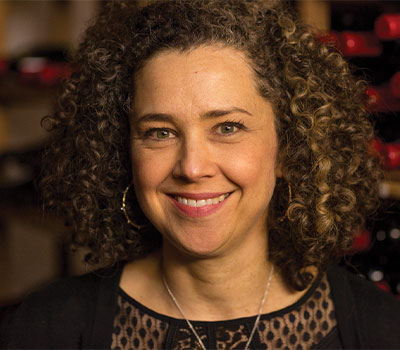Rebecca Banks has been building up her wine team post-pandemic, as Balthazar has not only fully reopened, but added 100 seats outdoors. Banks oversees the creative decisions here and at owner Keith McNally’s Minetta Tavern. Her colleague, wine and spirits manager Carolyn Morosanu, helps with buying decisions and handles purchasing for the two cellars, as well as for McNally’s Morandi. They hired a new cellar master at Balthazar, Andrew Avery. And, this year, McNally suggested they bring on a floor sommelier, Hannah Zingre. It’s been a boom year for Balthazar, and with the new team in place, both wine and spirits sales have increased markedly. —Joshua Greene


For the past four years, the trends at Balthazar have been pretty consistent, with most everything staying the same (wine’s share of the restaurant’s total sales, entrée prices, wine prices). This year, you pulled wine’s share of the restaurant’s total sales up more than 50%. What happened?
We increased our seats. This was the first year we saw a whole year of indoor-outdoor dining. When we reopened, we only opened at 30, then 50, then 75 percent capacity. Now we’re at 100 percent indoor-outdoor—187 seats inside and 100 seats outside, and we’re just crushing.
If you look at our liquor sales, they’ve doubled. People are drinking like crazy, and we’re turning tables faster. Breakfast could be two seatings; lunch could be two; and dinner could be three, and sales have just been very healthy.
You noted a 20 percent increase in entrée pricing and a 25 percent increase in wine pricing. How do those higher wine prices play out across your inventory?
When we came back, it was a little delicate to raise prices; we did not want to scare anyone away. This past year, we increased prices twice. We usually do that around the holidays and then, in the middle of last year, we increased prices again. I offset that dictate to raise prices by trying to find better deals. We can order in ten-case drops, or put a bill-and-hold on things we know we’re going to move. Both Caroline and I are trying to take advantage of those deals to bring the price down.
On things like Sancerre, I could raise the price, and nobody would care—it’s our top-selling white wine. We used to pay $11.67 for our by-the-glass Sancerre; now it’s $20. I can charge $26 for a glass of Sancerre, and no one bats an eye. I try to be very careful about what prices we’re raising and that we still offer good value. We’ve always been known for good prices on our list.
But it can’t be too cheap. I can’t put a wine on for $40 anymore, people would think there was something wrong with it.
We have a budget and a very low wine cost goal—every month our wine cost should be around 26 percent. A normal markup might hit a 30 percent cost, but on my by-the-glass wines, I could charge more. It used to be, whatever the cost of the bottle would be the cost of the glass. But now I’m not charging $10 for any glass. It doesn’t work for our clientele. The most aggressive might be 11 percent, though with waste—corks not going back in the bottle, the wine needing to be dumped—that’s more like 13 or 14 percent. That way, I can offset the $150 bottles we’ll sell at dinner. If I can’t meet that 26 percent cost, something else will have to suffer—staff… or meat… It’s a constant flux depending on the price of wine and what we’re selling. I’m always asking myself what is too much to charge for a hamburger or a glass of Chablis. There’s a certain expectation about what you’re going to pay at a certain type of place.
Before the pandemic, you were listing around 335 bottles, now it’s at 380. Where have you trended up, and where have you trended down?
We’ve increased Champagne a little bit, offering some smaller producers. Bordeaux has increased, it’s always been very popular, and we sell more and more of it. Now there are appellations that are more value driven, the Côtes, for example, to keep a certain price point and variety on the list. We increased some of the allocated older vintages, Classed Growths, Grand Cru Burgundy, because of an uptick in the last year and a half of people looking at those special items, but that’s still a small part of sales. The number fluctuates. We’re now in a no-reordering period, and then will build it back for the spring. It ebbs and flows.
You mentioned that customers are asking for Bordeaux. And you’re selling a lot of petits châteaux your guests would not likely know.
Because the wines are under $100, they’re red, and they’re Bordeaux. We have a Cadillac; it’s $68 and moves like wildfire. Anything under $100, but more than $60 or $70, flies. The Bordeaux thing is not new. But there seems to be an endless supply of Bordeaux.
We have one first-growth on the list. And I think we did sell one bottle of Pétrus over the holidays. But the trophy wines might make up one percent of sales. They are more like window dressing. It’s not what people are looking for here; we don’t have that kind of depth in our list.
Until recently, the servers were selling all the wine at Balthazar. How did your team decide to bring on a sommelier to work the floor?
One of our managers who’s been here for a year wanted to experiment with having a somm on the floor. The managers couldn’t personally touch every table, and there’s a lot of new staff. Even with training once a week, it’s not enough to get them up to speed.
Hannah Zingre is the floor somm, going to the tables, answering questions, helping get that second-bottle sale. It’s on-the-floor support with wine selection and service and helping with some pre-service wine education. That’s a big change , and she has been a tremendous help, especially during the holidays, when every seat was filled every hour of every day. More guests were asking for special wines, and we needed someone who could talk about those more confidently. Hannah came from the inside and knows the personality of the restaurant: It’s not a fancy restaurant, it’s high-quality but it’s a brasserie, and there’s a balance between fine-dining proper, but not formal service. I needed someone in that role who still embodies the style of the restaurant: proper, not formal.
Joshua Greene is the editor and publisher of Wine & Spirits magazine.
This is a W&S web exclusive. Get access to all of our feature stories by signing up today.


















